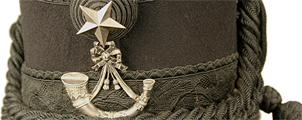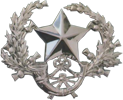One hundred years ago today, Sergeant John Erskine performed the deeds that would earn him the Victoria Cross, Britain’s highest award for gallantry in the face of the enemy. At the time, John was a Lance Corporal, Acting Sergeant, serving with the 5th Battalion The Cameronians (Scottish Rifles), a Territorial Force battalion whose headquarters were in the west end of Glasgow.

Men of the 5th Scottish Rifles, somewhere in France. John Erskine (11) is second right, middle row.

John Erskine, on the right, in a ‘dug-out’, while a comrade prepares their rations.
The war diary for the 5/6th Scottish Rifles of 22nd June 1916 records:
“In the early morning, one of the largest mines ever put up on the Western front was blown at the Duck’s Bill, by the Germans, and followed by one hour’s intense bombardment of the front and support lines. The enemy attacked with about 200 men and got into our trenches, but were very gallantly counter-attacked and driven out by the 2nd Royal Welsh Fusiliers. A company of the Royal Welsh Fusiliers who had had most of the fighting was relieved by a company of Cameronians, which in turn was relieved by “A” Company of Ours. LIEUT. STEVENSON, the Sapping Officer, was killed by a sniper while assisting in the consolidation of the crater. LANCE-CORPORAL ERSKINE was successful in bringing in two wounded men, and very gallantly went out over the open and attended to LIEUT. STEVENSON, lying beside him until a shallow trench had been dug to the spot where he lay, whereby he was brought into the trenches.”
For his actions that day, John had been recommended for the Victoria Cross. The London Gazette of 5th August 1916 confirmed the award, with the accompanying citation:
“On 22nd June 1916 at Givenchy, France, whilst the near lip of a crater caused by the explosion of a large mine was consolidated, Sergeant Erskine rushed out under continuous fire and rescued a wounded Sergeant & a Private. Later seeing his officer, who was lying in No-Man’s Land believed dead, showing signs of life, he ran to him, bandaged his head and remained with him for fully an hour, being repeatedly fired on. When assistance arrived, he helped bring the officer in, shielding him with his body to lessen the chance of him being hit again.”
John’s Victoria Cross medal forms part of the regimental museum collections of The Cameronians (Scottish Rifles), and can be seen on display in Low Parks Museum, Hamilton.
-

-
John Erskine’s Victoria Cross
-
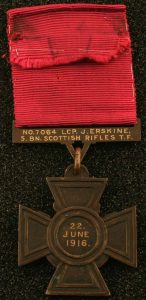
-
The inscription on the reverse of the medal
John Erskine did not survive the First World War. He was killed in action on 14th April 1917, still serving with the 5th (by this time 5/6th) Battalion Scottish Rifles. John has no known grave and is commemorated on the Memorial to the Missing at Arras. John’s younger brother, William, had been killed in November 1916, serving with the Highland Light Infantry.
Today, John’s heroism was marked by the unveiling of a commemorative stone in his native Dunfermline. The memorial stone was unveiled in the Garden for Heroes, near Dunfermline Abbey, by John Erskine’s niece, Lieutenant Colonel Helen Homewood MBE.
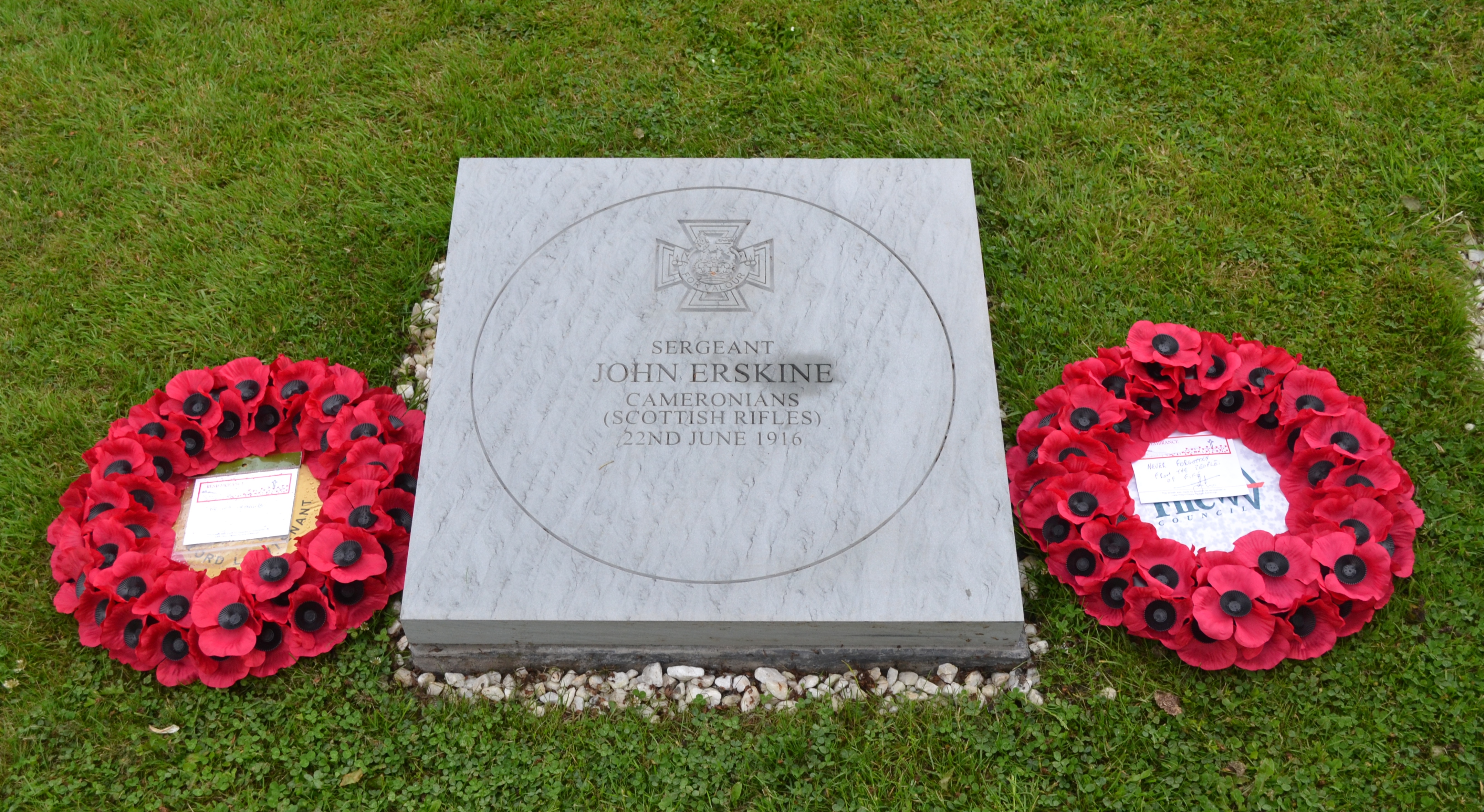
The commemorative stone to John Erskine VC, unveiled today in Dunfermline’s Garden for Heroes.
Comments:
Charles Douglas Willoughby Rooke, known as Frankie to his fellow officers, served with the 1st Battalion The Cameronians (Scottish Rifles) during the First World War. He was killed in action on 19th June 1915, only a couple of weeks before his 21st birthday. Charles is just one of the men immortalised in the fantastic photographs that survive in the regimental collection, a selection of which appear in this article, published on the anniversary of his death.
Charles was commissioned into the 1st Battalion The Cameronians (Scottish Rifles) on 17th September 1913. The Rooke family had a long connection with the British Army, and in particular with the Scots Guards regiment with which several generations of his family had served. Why Charles broke with family tradition and joined The Cameronians is not known, particularly when, as a Roman Catholic, he would be joining a regiment renowned for it’s Protestant origins.
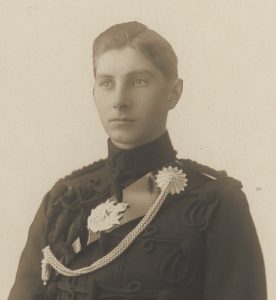
Second Lieutenant Charles D. W. Rooke, most likely taken shortly after his appointment to the Regiment
Charles accompanied the 1st Battalion to France as part of the British Expeditionary Force, arriving in France on August 16th 1914. He was promoted to Lieutenant in late 1914, and served with ‘C’ Company. Captain, later Brigadier-General, James Jack would go on to record in his diary of December 23rd 1914:
“My subalterns, Harry Becher, ‘Frankie’ Rooke and Darrell Hill, have come through all the engagements from Mons without a scratch, or sickness or broken nerves. They are a tough trio of first-class, cool-headed, cheery young officers.”
At the action near La Boutillerie on October 22nd, Captain H. W. Rose, Charles’ Company Commander, was fatally wounded. One of the soldiers who tried to assist the dying officer was Corporal Arthur Honeyball, who was himself badly wounded in the attempt. Corporal Honeyball fortunately survived his wounds, and left an account of that day:
“…when we got to Captain Rose I asked him where he had got it , he said in the back, as soon as he said that, he got another that killed him. I had got hold of him by the feet, and the other chap had got hold of his shoulders, by the time he got the second shot. And then I got mine through the thigh. I must have fainted after that, because when I came to my senses I was in a ditch and no one seemed near me, and I did not know which way to go. The shots were whizzing overhead, and then there was a lull in the firing, so I thought I would look and see if I recognised anything. I then knew which way to go. I was dragging myself along, when I caught sight of a house, so I thought if I could manage to get there I might be alright. So I kept on and it seemed like hours, although the distance was not more than 500 yards from where I was wounded. I got to within 50 yards of the house when I caught sight of some of my regiment in the trenches they had made. When I saw them I said “Thank God”. Mr Rooke, a young Lieutenant, came and helped me up to the house that I was trying to get to, then he called the stretcher bearers and they carried me back to where the doctor was…”

‘Frankie’, centre, holding the hand of a young French girl, with officers and men of ‘C’ Company
Charles was himself wounded on January 5th 1915, while the Battalion were holding the line near the village of Bois Grenier, and sent back to the UK to recuperate. Captain Jack recorded the incident in his diary:
” ‘Frankie’ Rooke was badly wounded this morning by a bullet in the groin. With just a field dressing bandaged on by the company stretcher-bearers, he had to lie in our shelter all day in considerable pain until he could be carried back safely at dusk to the ambulance.”
At the beginning of April 1915, Charles was back in France, having spent a short spell with the 3rd (Special Reserve) Battalion in the north of Scotland. He returned to the 1st Battalion, who were still in the Bois Grenier sector, on April 27th.
During a relatively quiet spell in the trenches in early May, the officers of ‘C’ Company posed for a photograph while enjoying their afternoon tea.
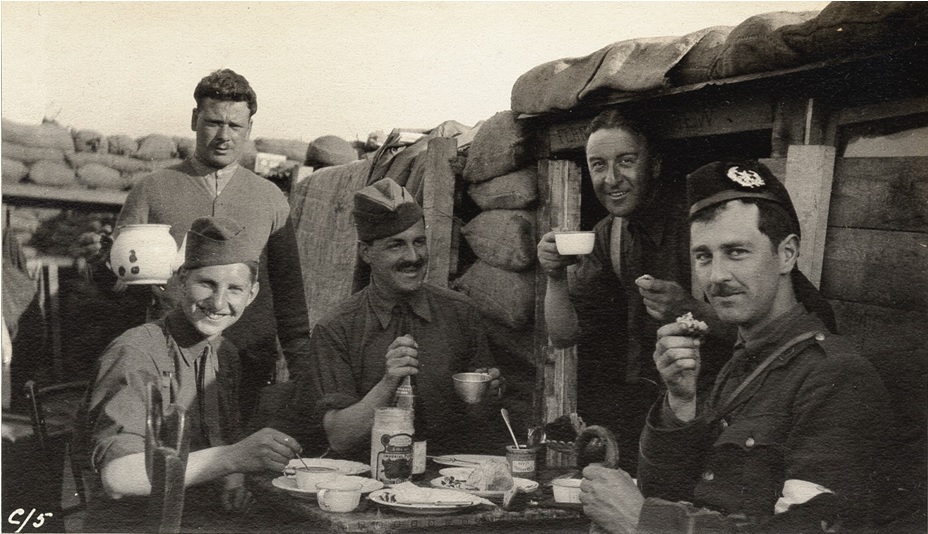
Officers of ‘C’ Company enjoying afternoon tea, 11th May 1915, Bois Grenier sector
The officers are, left to right; Lieutenant Rooke, Lieutenant J. D. Hill, Captain C. C. Scott, and Lieutenant M. N. Gray – the soldier in the background holding the teapot is presently unidentified.
Rooke appears again in another photograph taken on 20th May 1915, this time showing the officers and non commissioned officers of ‘C’ Company in rest billets. Charles is standing second from the right. Only five days earlier he had been slightly wounded in the cheek in an accident involving a grenade. This is one of the last photographs in which Charles appears.
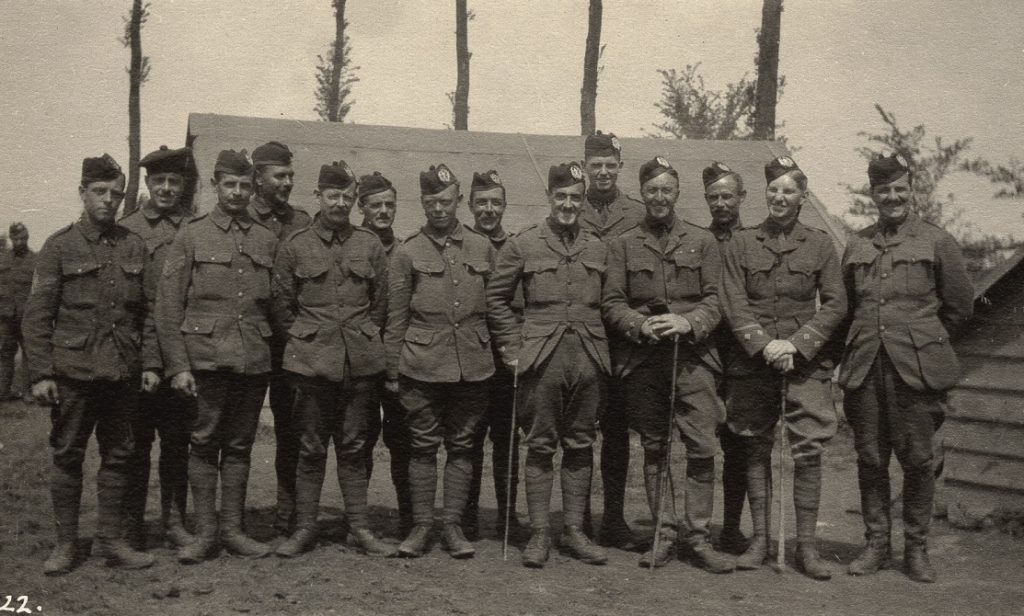
Officers and Non Commissioned Officers, ‘C’ Company, 20th May 1915
On the evening of 19th June 1915, Charles was killed leading a patrol to try and take a German listening post. Major J. G. Chaplin, Commanding Officer of the 1st Battalion The Cameronians (Scottish Rifles) wrote to Charles’ mother, explaining what had happened to her son:
“I am writing to express to you the sincere sympathy of the officers of the Cameronians in the terrible loss which you have suffered. His death is a great blow to the regiment, for he was loved alike by officers and men. He has been so brave and cheery during the whole campaign. I will tell you as well as I can the manner of his death.
The trenches we were occupying were about 300 yards from those of the Germans. On the 19th your boy went out with a patrol of six men to try and capture or destroy a German ‘listening post,’ which was about 100 yards in front of their trenches. The patrol approached the German lines by a ditch which ran from our trenches to theirs. When they were close to the ‘listening post’ the patrol got out of the ditch and spread out on either side, your boy being in the centre close to the ditch, and Private Roberts, who carried bombs, was close to him. They saw some Germans about ten yards from them, and your boy fired four shots with a rifle, and ordered Roberts to throw bombs. Roberts threw two, one of which exploded amongst the Germans. The Germans opened a heavy fire, and Roberts and your boy sprang into the ditch, and the rest of the patrol did the same, and retired a little. Roberts found that your boy was hit and tried to carry him back, but could not do so, so he went back and told the other men – one of them went back and informed Captain Scott of what had happened. Captain Scott sent out Gray, another Subaltern of the Company, who, with the assistance of two other men, most gallantly brought in your boy. The doctor examined him, but he was quite dead, shot through the heart, and death must have been instantaneous – quite painless.
We buried him yesterday afternoon in Bois Grenier, beside Stirling, Becher (his Captain of ‘C’ Company), and Wedderburn. General Robertson attended the funeral, which was conducted by Father MacShane.”
In a tragic twist, Lieutenant Magnus Gray, who had helped bring Charles back to the British line, was shot in the head by a sniper the next day, and died on 21st June 1915. Major Chaplin continued in his letter:
“Poor Gray, who brought in your boy, was killed himself yesterday by a sniper. He asked that if he should be killed that he might be buried beside your boy, and we are doing so.”
If you visit Brewery Orchard Cemetery in Bois Grenier today, you will find the graves of Captain James Stirling, Lieutenant Robert Wedderburn, Captain Henry Becher, and Lieutenants Charles Rooke and Magnus Gray, all of the 1st Battalion Cameronians, buried side by side in a little plot towards the rear of the cemetery. They were among the first to be buried there, the cemetery growing around them as the War wore on. Today the cemetery contains 339 Commonwealth burials from the First World War.
Comments:
Earlier this year, Low Parks Museum in Hamilton was host to the First World War partnership exhibition, Next of Kin, coordinated by National Museums Scotland. As part of this exhibition, a commemorative scarf was made by two volunteers from Hillhouse Parish Church. The hand-knitted scarf is a reference to the wartime effort by volunteers at home who would knit hats, scarfs, gloves and socks for the comfort of soldiers at the front.

Commemorative Scarf, created by volunteers for the ‘Next of Kin’ exhibition
The volunteers, Marion and Margaret, decided to create this scarf in the regimental colours of The Cameronians (Scottish Rifles), green, blue, and black, and used a thick, ribbed pleating to echo the pleats of a piper’s kilt. They also added the name ‘James Lusk’ to the scarf; Captain James Lusk featured in our display as part of the Next of Kin exhibition. James was a native of Strathaven, South Lanarkshire, and a manager in the famous iron and steel company David Colville & Sons. Tragically, James died on 28th December 1915, of serious wounds he had received on Christmas Day while handing out cigarettes to the men in his battalion.
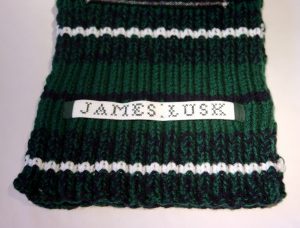
Captain James Lusk is commemorated on the scarf
While visiting The Cameronians displays in Low Parks Museum, Margaret had seen the objects on display that tell the story of Alexander Harris and William Wilson, who were the the subject of a previous blog post. Touched by the story of the two young pals, Margaret and Marion decided to add their names to the scarf.
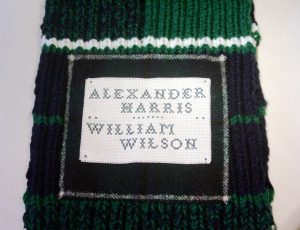
The names of Alexander Harris and William Wilson were added to the scarf, fixed to the same piece of Douglas tartan cloth
Margaret said that she had been struck by “how these young pals had enlisted together for Kitchener’s New Army, just like so many friends from every town, village and city throughout the country. The story of two ordinary boys who would become soldiers, signing up together with consecutive service numbers, just like so many others whose stories have been forgotten, and how they would have trained and fought together and for one of them to ultimately die and just how devastating this must have been to the other.”
You can see the scarf on display at Low Parks Museum, alongside a photograph of Alexander and William.
-

-
William (left) and Alexander
-
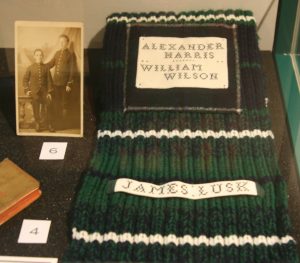
-
The scarf on display at Low Parks Museum
We would like to thank Margaret and Marion for all their hard work.
The Next of Kin exhibition is currently on tour, for venue details and dates please see the National Museums Scotland website for details – http://nms.ac.uk/national-international/sharing-collections/touring-and-lending/next-of-kin/touring-exhibition/
Comments:



